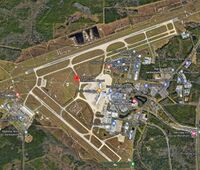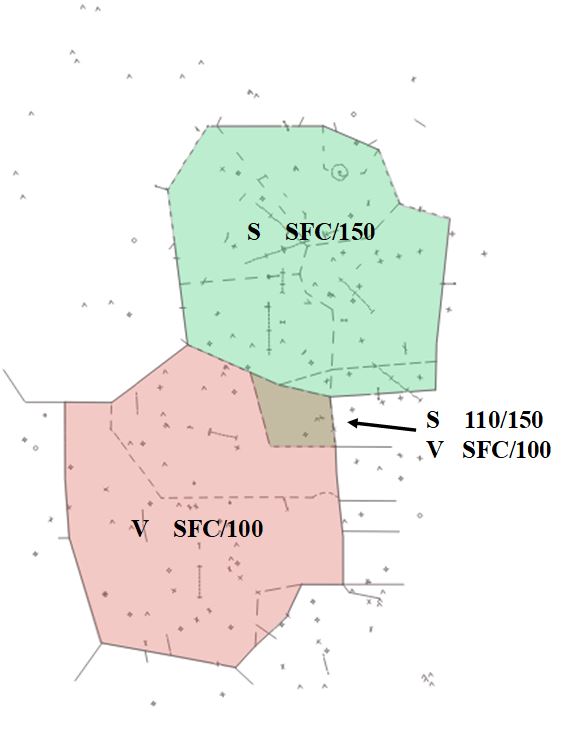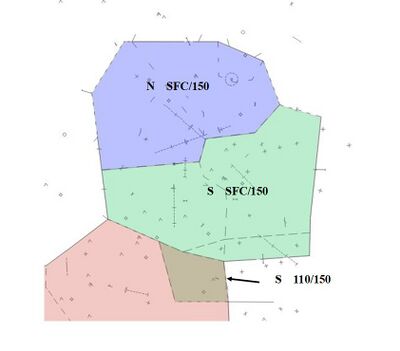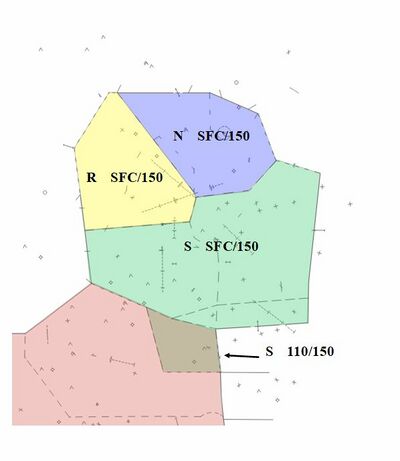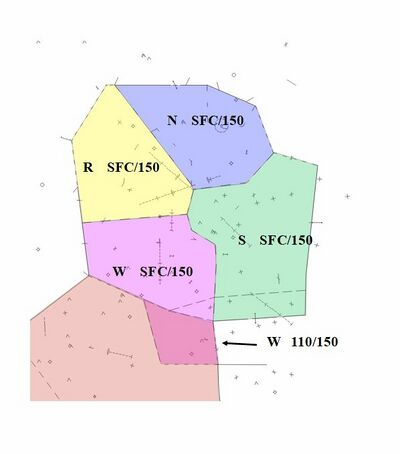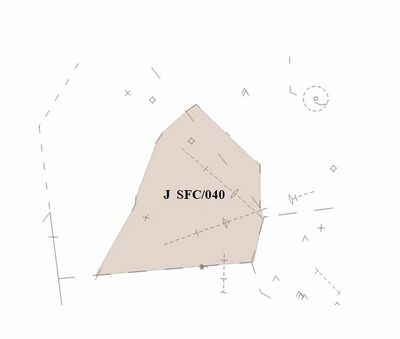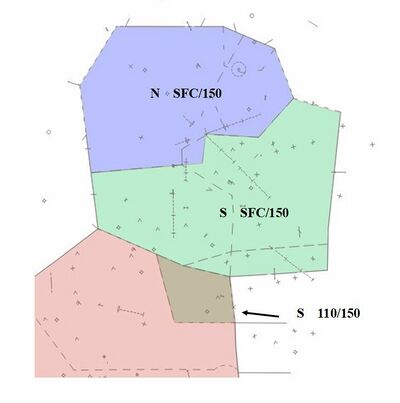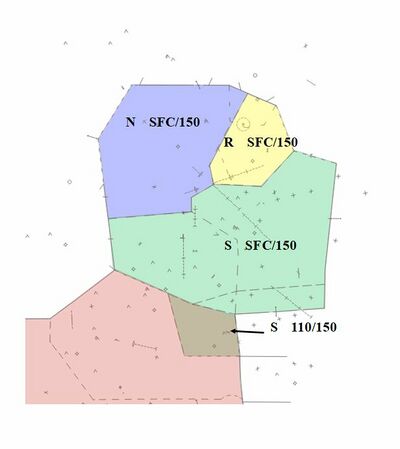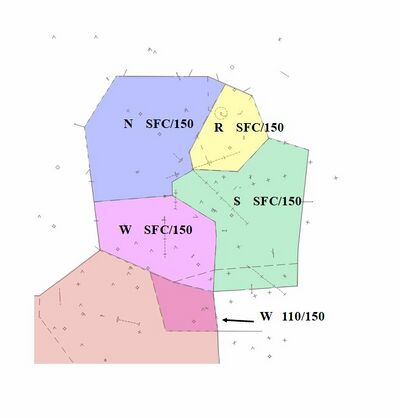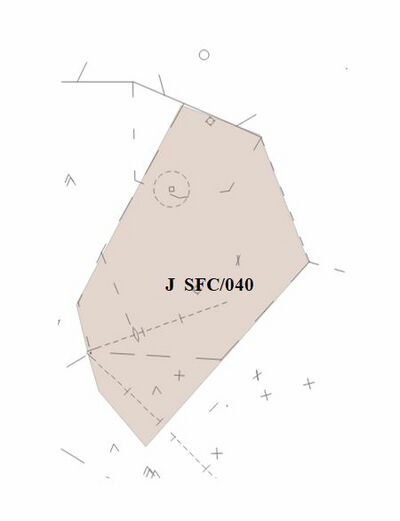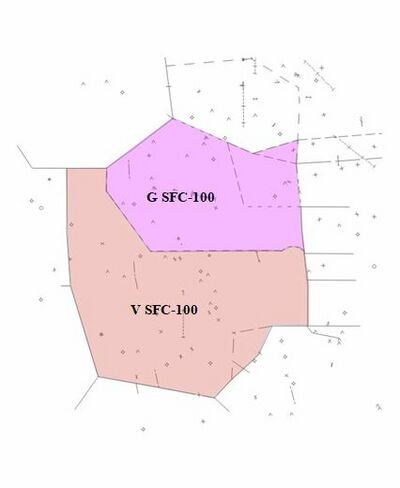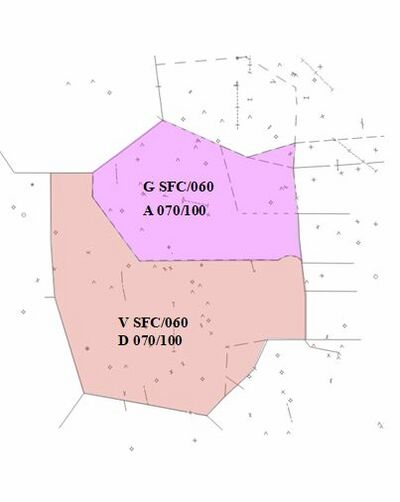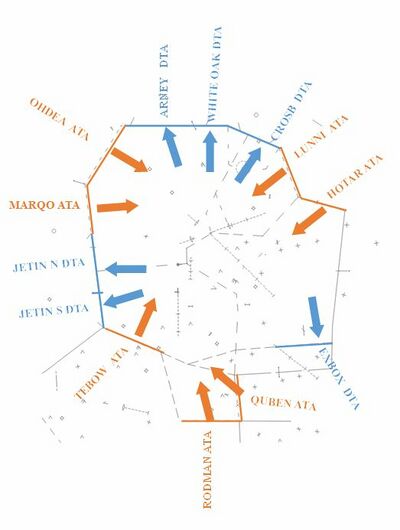Jacksonville ATCT/Tracon
Table of Updates
| Date | Revision | Items Revised |
|---|---|---|
| 17 April 2023 | A | Calm Wind Departing and Arriving Runways |
| 7 May 2023 | B | Updated of Page Organization/PDC Commands/Phraseology Examples/Add Satellite Fields |
| 9 May 2023 | C | Lineup and Wait added |
| 22 May 2023 | D | ATL/PDK Bound LOA Agreement Added |
| 18 June 2023 | E | Removal LOAs, Added LUAW Section, Organization |
| 15 July 2023 | F | Update of Departure Heading, Go-Around Procedures |
| 26 August 2023 | G | Removed ARNEY SID, Added BRSTL SID |
| 18 March 2024 | H | Updated Primary Tracon Frequency and Position, Updated Approach Sectors, Added DTA and ATA for Non-RNAV Departures and Non-Star Arrivals. Updated instruction to remove on course for JAX# Departures. |
Area Information
| ICAO Code | Airport Name | Airspace | IFR Beacon Codes | VFR Beacon Codes |
|---|---|---|---|---|
| KJAX | Jacksonville International Airport | C | 2601-2677 | 2601-2677 |
| KCRG | Jacksonville Executive Airport at Craig | D | ||
| KGNV | Gainsesville Regional Airport | D | ||
| KNEN | Whitehouse NOLF Airport | D | ||
| KNIP | Jacksonville Naval Air Station (Towers Field) | D | ||
| KNRB | Mayport Naval Station | D | ||
| KOCF | Ocala International Airport | D | ||
| KSGJ | Northeast Florida Regional Airport | D | ||
| KVQQ | Cecil Airport | D |
| Purpose This document prescribes the procedures to be utilized for providing air traffic control services at the Jacksonville Air Traffic Control Tower (JAX ATCT) and TRACON. The procedures described herein are supplemental to the Jacksonville ARTCC Facility Operating Guidelines and FAA Order JO 7110.65, as well as any published FAA guidelines or procedures. Distribution |
Operational Positions
| Position | Radio Name | Callsign | Relief Callsign | Symbol | Frequency |
|---|---|---|---|---|---|
| Clearance Delivery | Jacksonville Clearance Delivery | JAX_DEL | JAX_1_DEL | 3JD | 119.500 |
| Ground | Jacksonville Ground | JAX_GND | JAX_1_GND | 3JG | 121.900 |
| Tower | Jacksonville Tower | JAX_TWR | JAX_1_TWR | 3JT | 118.300 |
| Position | Sector Name | Callsign | Relief Callsign | Symbol | Frequency |
|---|---|---|---|---|---|
| N | Radar North | JAX_N_APP | JAX_1N_APP | 3N | 127.000 |
| W | Radar West | JAX_W_APP | JAX_1W_APP | 3W | 127.775 |
| E | Radar East | JAX_E_APP | JAX_1E_APP | 3E | 132.775 |
| R | Radar Arrival | JAX_R_APP | JAX_1R_APP | 3R | 119.000 |
| J | Radar Final | JAX_J_APP | JAX_1J_APP | 3J | 119.850 |
| S | Radar Satellite | JAX_S_APP | JAX_1S_APP | 3S | 124.900 |
| A | Radar Palatka | JAX_A_APP | JAX_1A_APP | 3A | 121.300 |
| G | Radar Gainesville | JAX_G_APP | JAX_1G_APP | 3G | 118.175 |
| D | Radar Dunnellon | JAX_D_APP | JAX_1D_APP | 3D | 128.675 |
| V | Radar Vitts | JAX_V_APP | JAX_1V_APP | 3V | 118.600 |
Sector in Red is the primary sector.
| Airport | Position | Radio Name | Callsign | Relief Callsign | Frequency |
|---|---|---|---|---|---|
| KCRG- Jacksonville Executive Airport at Craig | Clearance Delivery | Craig Delivery | CRG_DEL | CRG_1_DEL | 118.350 |
| Ground | Craig Ground | CRG_GND | CRG_1_GND | 121.800 | |
| Tower | Craig Tower | CRG_TWR | CRG_1_TWR | 132.100 | |
| KGNV- Gainsville Regional Airport | Ground | Gainesville Ground | GNV_GND | GNV_1_GND | 121.700 |
| Tower | Gainesville Tower | GNV_TWR | GNV_1_TWR | 119.550 | |
| KNEN- Whitehouse Naval Outlying Field | Tower | Whitehouse Tower | NEN_TWR | NEN_1_TWR | 125.15 |
| KNIP- Jacksonville Naval Air station (Towers Field) | Clearance Delivery | Navy Jacksonville Clearance Delivery | NIP_DEL | NIP_1_DEL | 134.775 |
| Ground | Navy Jacksonville Ground | NIP_GND | NIP_1_GND | 128.600 | |
| Tower | Navy Jacksonville Tower | NIP_TWR | NIP_1_TWR | 125.150 | |
| KNRB- Mayport Naval Station | Ground | Navy Mayport Ground | NRB_GND | NRB_1_GND | 126.500 |
| Tower | Navy Mayport Tower | NRB_TWR | NRB_1_TWR | 118.750 | |
| KOCF- Ocala International Airport | Ground | Ocala Ground | OCF_GND | OCF_1_GND | 121.400 |
| Tower | Ocala Tower | OCF_TWR | OCF_1_TWR | 119.250 | |
| KSGJ- Northeast Florida Regional Airport | Ground | St Augustine Ground | SGJ_GND | SGJ_1_GND | 121.175 |
| Tower | St Augustine Tower | SGJ_TWR | SGJ_1_TWR | 127.625 | |
| KVQQ- Cecil Airport | Clearance Delivery | Cecil Clearance Delivery | VQQ_DEL | VQQ_1_DEL | 123.975 |
| Ground | Cecil Ground | VQQ_GND | VQQ_1_GND | 121.625 | |
| Tower | Cecil Tower | VQQ_TWR | VQQ_1_TWR | 126.100 |
Clearance Delivery
Clearance Delivery Responsibilities
The Clearance Delivery Controller Must:
- Formulate and issue all IFR clearances to aircraft departing this field.
- Review proposed flight plan information for accuracy and amend routings and altitudes, as necessary, in accordance with this SOP.
- Enter amendments to flight plans into the controller client as required and advise the pilot what those amendments are.
- Issue clearances or route changes to aircraft, as required complying with traffic management initiatives and/or weather avoidance.
- Forward and await a response on all non-standard routing requests to the affected facilities.
- During Events: Do not change routes or proposal times for aircraft participating in Traffic Management programs without prior coordination with the controller in charge.
Pre-Departure Clearances
It is advisable that ALL controllers issue PDCs for departures for KJAX INTL ATCT
PDC Commands
If Jacksonville Approach or Jacksonville Center is Online: .pdcj {Departure Runway} {Dep Frequency ID}
If Jacksonville Approach and Jacksonville Center is Offline: .pdcju {Departure Runway}
IFR Departures
Planned/Amended Routing
RNAV Departure: All Aircraft shall be "cleared via {Departure} {Fix} Transition then as filed" unless a route amendment is necessary.
Non-Rnav 10,000 and above: Aircraft shall be "cleared via the Jacksonville # departure, radar vectors {fix} then as filed" unless a route amendment is necessary.
Non-Rnav Under 10,000: Aircraft shall be "cleared via radar vector {fix} then as filed" unless a route amendment is necessary.
Departures
- BRSTL= Northwest Bound (Turbojets Only)
- CROSB= Northeast Bound (Turbojets Only)
- EXBOX= Southeast Bound (Turbojets Only)
- JAX= Radar Vector Departure (Procedure NA for aircraft filed below 10000)
- JETIN= West and Southwest Bound (Turbojets Only)
- SAWGY= Southeast Bound
Note: Scratchpad entry shall be entered for all departures out of Jacksonville. The scratchpad should contain the first 3 letters of the departures.
Assigned Altitudes
Aircraft shall be instructed to maintain 3,000 feet and to expect their cruise altitude (if higher) ten minutes after departure.
All IFR Aircraft conducting practice approaches shall maintain 3,000 feet
Departure Frequency
The Primary Departure Frequency is JAX_S_APP on 124.900.
Squawk Assignment
All IFR Squawk codes will be auto-assigned by the controller client.
It should assign a code between 2601-2677. Controllers shall not change the auto-assigned code if a code between 2601-2677 is not assigned.
VFR Departures
Clearance
VFR Aircraft do not need explicit clearance to enter or exit the airspace.
All VFR remaining in the pattern will require coordination with the tower and will be directed to contact when ready for taxi.
Assigned Altitudes
Not Remaining in the Pattern
Jet: VFR aircraft shall be instructed to maintain VFR at or below 3,000.
Turboprops: VFR aircraft shall be instructed to maintain VFR at or below 3,000.
Props: VFR aircraft shall be instructed to maintain VFR at or below 3,000.
Departure Frequency
Aircraft not remaining in the pattern shall be given the appropriate Departure Frequency.
Aircraft remaining in the pattern shall not be given a departure frequency.
Squawk Assignment
VFR Squawk codes shall be assigned by the controller client using the assign squawk feature in their controller client for all traffic not remaining in the pattern.
Ground
General Information
Ground Control Responsibilities
The Ground Controller is responsible for the movement of vehicles and aircraft on the airport movement areas except for the active runway(s)
ATIS
Ground control shall confirm all pilots have the current ATIS code PRIOR to commencing taxi to the active runway. This can be achieved by requesting the pilot "state the current ATIS code". The ATIS is the responsibility of the tower controller.
Active Runway Operations
Except for runway crossings, Ground Control must transfer communication to Local Control if a vehicle/aircraft is to operate on a runway. Coordination for all runway crossings must be accomplished by requesting permission from local control by stating "(Number of Aircraft) to cross Runway (#) at Taxiway (Letter). Once approved and crossing has been granted and the crossing has been observed, ground control must state to local control "Runway (#) crossing complete"
Intersection Departures
Ground Control must advise local control of all intersection departures verbally.
Opposite Direction Departures
Ground Control must coordinate and obtain approval from Local Control, prior to taxiing an aircraft to a runway for an opposite-direction departure.
Pushback and Startup
Push back into a controlled area: Aircraft shall be instructed: "Push and Start Approved, tail facing (direction)." The direction should keep the aircraft pointed in the direction the aircraft will taxi.
Push back will not enter a controlled area: Aircraft shall be instructed: "Push and start at pilot's discretion."
Runway Assignments
The runway assignment should be the runway closest to the position of the aircraft based on the Active Runway Assignments as selected by the Local Controller.
Taxi Operations
As the taxiways at Jacksonville are simple, there are no defined routes for taxi.
NOTE: Do not direct an aircraft leaving the runway to hold short of the parallel taxiway without prior approval from LC.
Transfer of Communication
Departing aircraft shall be instructed to contact the local control frequency upon or slightly before holding short the runway for departure. Local control has the option to have the pilot "monitor" the frequency. If a pilot is going to monitor, ground control must send a private message via the controller client of the aircraft with their callsign and runway.
Tower
Active Runway Selection
The active runway shall be determined based on wind and known factors that may affect the safety of takeoff/landing operations.
East Operations is designated as the calm wind runway.
- East Ops: Runway 8 and 14. It is recommended that VFR traffic remaining in the pattern use runway 8.
- West Ops: Runway 26 and 32. It is recommended that VFR traffic remaining in the pattern use runway 26.
Area of responsibility
LC has responsibility for a five mile radius from the JAX field from surface up to and including 3,000 MSL.
Arrival Procedures
LC shall be responsible for separation of all arrival aircraft that have been handed off by TRACON from all departing aircraft still under LC jurisdiction
Practice Instrument Approaches: Issue special instructions as verbally coordinated with the TRACON. Practice Instrument Approaches shall assign runway heading and maintain 3,000 feet. Departure frequency as assigned by approach control.
LC shall NOT change the approach sequence without coordination. Communication transfer must be completed prior to five nautical miles from the runway.
Automatic Terminal Information Service
LC shall manage the ATIS
The ATIS shall be on 125.850
Automatic Releases
LC is authorized automatic releases from the TRACON controller so long as the aircraft departs on the pre-coordinated active departing runway(s) on approved departure headings
In order for automatic releases to be authorized, procedures in this document shall be followed.
Departure releases must be obtained if automatic releases are suspended by TRACON.
Departure Procedures
LC will provide separation for aircraft in the LC airspace. LC shall provide initial radar separation between successive departures. When automatic departures are in effect, IFR jet/turbojet departures shall be released on the appropriate heading climbing to 3,000 feet. When automated departures are in effect, VFR may be released on the appropriate heading climbing at or below 3,000.
Departure Headings
Standard Turbojet Departure Headings
| To "N" or "W" | Heading | To "S" | Heading | |
|---|---|---|---|---|
| EAST OP (Runway 8/14) |
Runway 8 | 080° | Either Runway | 140° |
| Runway 14 | 070° | |||
| WEST OP (Runway 26/32) |
West and Southwest Bound Departures | 260° | Either Runway | 220° |
| All Others | 320° |
Alternate Headings for Separation/Prop Headings
Assign an alternate departure heading as depicted to achieve separation between IFR departures.
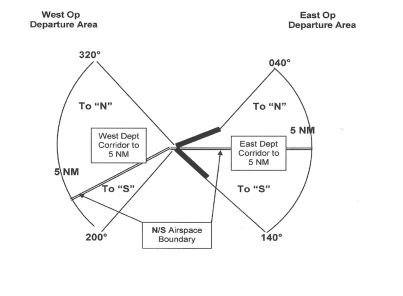
Go Around/ Unplanned Missed Approaches
LC must verbally coordinate with departure prior to frequency change.
The controller will assign runway heading and 3,000 unless otherwise stated.
Land and Hold Short
N/A
Line Up and Wait
Line up and wait is authorized at this field only in VMC Conditions. LUAW departures from an intersection are only authorized between sunrise and sunset.
Traffic Pattern
The VFR pattern will be at or below 1,500 feet. Runway 8 and 32 will utilize left hand pattern. Runway 14 and 26 will utilize right hand pattern.
Visual Tower
Jacksonville ATCT is a visual/VFR tower and shall not initiate or accept any radar handoffs and shall not initiate control/start track on any target.
TRACON Information
TRACON Airspaces/Splits
| East Ops (2-way) |
|
| East Ops (3-way) |
|
| East Ops (4-way) |
|
| East Ops (5-way) |
|
| East Ops J-Final Sector |
|
| West Ops (2-way) |
|
| West Ops (3-way) |
|
| West Ops (4-way) |
|
| West Ops (5-way) |
|
| West Ops J-Final Sector |
DTA/ATA Information
| Jacksonville DTA/ATA |
The following table depicts Jacksonville’s various departure transition areas (DTAs) for the departure radar and satellite radar positions. These DTAs are to be used by their respective radar positions only. When Jacksonville is in a “combined” configuration, the combined controller is authorized to use all DTAs. All Departures NOT on an RNAV SID out of Jacksonville or NOT on a STAR into Jacksonville Airspace must enter the airspace via an DTA or ATA (As Appropriate)
| Direction | Examples | DTA |
| North | CHS, SAV, SSI | CROSB DTA |
| Northwest | AMG, AGS, IRQ | ARNEY DTA |
| West | TAY | JETIN N DTA |
| South West | CAPOH, FELTZ, GNV, JAYJA, LAL, OCF, PIE, VARZE | JETIN S DTA |
| South | FOXAM, SAWGY | EXBOX |
Arrival Procedures-General
The sector responsible for the primary runway shall establish the approach sequence for all arrivals.
Communications transfer of arriving aircraft to LC must be accomplished no later than five nautical miles from the end of the arrival runway.
When simultaneous approaches are being conducted on converging runways, LC is responsible for ensuring runway separation. However, TRACON must provide enough spacing to minimize the possibility of a go-around.
When vectoring to final from parallel downwinds, aircraft on opposing base legs shall be assigned altitudes to ensure vertical separation unless other approved separation has been applied. This ensures separation in the event of an overshoot on final.
Coordinate with LC for any aircraft conducting approaches to other runways than the active arrival runway(s) in use.
SHREK# will be descended from Enroute to traverse DUNNELLON/VITTS and shall be descended to 7,000 with a hand off to the appropriate F11 sector.
Departure Procedures-General
During East Flow, Turbojets that are west or southwest bound should be vectored counterclockwise north of KJAX.
During West Flow, Turbojets that are northeast bound should be vectored clockwise north of KJAX.
Forward departure instructions to LC for aircraft executing practice missed approaches.
Ensure all RNAV departures are on course as soon as practical. All other departures should be positioned through a DTA
Aircraft shall be climbed to 15,000 or less if filed.
Provide airspace for automatic departures and radar final.
Provide airspace for missed approach on all runways.
Handoff and Radar Tracking
Jacksonville ATCT is a VFR tower. No radar handoffs shall be initiated to LC.
TRACON controllers shall not drop the track on any arriving aircraft. This allows a controller to maintain radar identification during missed approach.
Release and Rolling Calls
TRACON sectors give automatic releases to all departures from Jacksonville ATCT when departures follow the standard departure procedures as specified in this document.
All other airports within TRACON’s boundaries shall request a departure release. Upon approval of the release, the release shall be good for five minutes.
Upon issuance of the takeoff clearance, a departure message shall be sent to the appropriate departure sector. This can be accomplished non-verbally by the LC ensuring the aircraft is squawking the appropriate squawk code and mode C is enabled when airborne.
VFR Aircraft within TRACON
VFR Aircraft entering the Class Charlie airspace will be given a discrete beacon code.
If an aircraft departs from JAX and does not request a flight following, the aircraft will be handed off from LC to TRACON and released to UNICOM once clear of the Class Charlie.
Phraseology
{Callsign}, Change to Advisory Frequency Approved, squawk 1200.
7110.65Z Class C Service- Terminal
JAX STARS MAP LIST
KCRG- Jacksonville Executive Airport at Craig
Initial Altitude for all IFR Departures is 2,000 feet. Pilots shall expect their cruise (if higher) in 10 minutes after departure.
There is no published departure procedures for Jacksonville Executive, All aircraft will be cleared to their destination as filed.
Phraseology
{Callsign}, You are cleared to the {Arrival Airport} Airport as filed. Maintain 2,000, expect {cruise} one-zero minutes after departure. Departure Frequency {departure frequency}, squawk {squawk code}.
As the taxiways at Jacksonville Executive are simple, there are no defined routes for taxi.
Phraseology
To Runway
{Callsign}, Runway {Number} taxi via {taxi instructions}.
To Ramp
{Callsign}, Taxi to the ramp via {taxi instructions}.
ALL IFR DEPARTURES REQUIRE RELEASE
Departure Procedures
LC will provide separation for aircraft in the LC airspace.
LC shall provide initial radar separation between successive departures.
LC has the option to assign all NON-JET aicraft runway heading or a fanned heading up to 30 degrees each direction.
Phraseology
{Callsign}, {Departure Instruction}, Wind {direction} at {speed}, Runway {Runway}, Cleared for takeoff
{Callsign}, Contact Departure {frequency}
Arrival Procedures
LC shall be responsible for separation of all arrival aircraft that have
been handed off by TRACON from all departing aircraft still under LC
jurisdiction
Phraseology
{Callsign}, {Traffic Advisories} , Wind {direction} at {speed}, Runway {Runway}, Cleared for land
Practice Instrument Approaches: Issue special instructions as verbally coordinated with the
TRACON. Practice Instrument Approaches shall assign runway heading and maintain 2,000 feet. Departure frequency as assigned by approach control.
Phraseology
{Callsign}, Fly Runway Heading, Climb and Maintain 2,000, Contact Approach on {Frequency}
LC shall NOT change the approach sequence without coordination. Communication transfer must be completed prior to five nautical miles
from the runway.
The active runway shall be determined based on wind and known
factors that may affect the safety of takeoff/landing operations.
Runway 14 is designated as the calm wind runway.
7110.65Z Runway Selection
LC shall assign IFR aircraft runway heading and 2,000 feet
LC must verbally coordinate with departure prior to frequency change.
Phraseology
AFTER COORDINATION WITH TRACON: {Callsign}, Fly {Heading}, Climb and Maintain {Altitude}, Contact Approach on {Frequency}
Jacksonville Executive ATCT is a visual/VFR tower and shall not initiate or accept any radar handoffs and shall not initiate control/start track on any target.
LC shall manage the ATIS for KCRG
The ATIS shall be on 125.400
KGNV- Gainesville Regional Airport
Initial Altitude for all IFR Departures is 2,000 feet. Pilots shall expect their cruise (if higher) in 10 minutes after departure.
There is no published departure procedures for Gainesville Regional, All aircraft will be cleared to their destination as filed.
Phraseology
{Callsign}, You are cleared to the {Arrival Airport} Airport as filed. Maintain 3,000, expect {cruise} one-zero minutes after departure. Departure Frequency {departure frequency}, squawk {squawk code}.
As the taxiways at Gainesville Regional are simple, there are no defined routes for taxi.
Phraseology
To Runway
{Callsign}, Runway {Number} taxi via {taxi instructions}.
To Ramp
{Callsign}, Taxi to the ramp via {taxi instructions}.
ALL IFR DEPARTURES REQUIRE RELEASE
Departure Procedures
LC will provide separation for aircraft in the LC airspace.
LC shall provide initial radar separation between successive departures.
LC has the option to assign all NON-JET aicraft runway heading or a fanned heading up to 30 degrees each direction.
Phraseology
{Callsign}, {Departure Instruction}, Wind {direction} at {speed}, Runway {Runway}, Cleared for takeoff
{Callsign}, Contact Departure {frequency}
Arrival Procedures
LC shall be responsible for separation of all arrival aircraft that have
been handed off by TRACON from all departing aircraft still under LC
jurisdiction
Phraseology
{Callsign}, {Traffic Advisories} , Wind {direction} at {speed}, Runway {Runway}, Cleared for land
Practice Instrument Approaches: Issue special instructions as verbally coordinated with the
TRACON. Practice Instrument Approaches shall assign runway heading and maintain 3,000 feet. Departure frequency as assigned by approach control.
Phraseology
{Callsign}, Fly Runway Heading, Climb and Maintain 3,000, Contact Approach on {Frequency}
LC shall NOT change the approach sequence without coordination. Communication transfer must be completed prior to five nautical miles
from the runway.
The active runway shall be determined based on wind and known
factors that may affect the safety of takeoff/landing operations.
Runways 7 and 11 are designated as the calm wind runways.
7110.65Z Runway Selection
LC shall assign IFR aircraft runway heading and 3,000 feet
LC must verbally coordinate with departure prior to frequency change.
Phraseology
AFTER COORDINATION WITH TRACON: {Callsign}, Fly {Heading}, Climb and Maintain {Altitude}, Contact Approach on {Frequency}
Gainesville Regional ATCT is a visual/VFR tower and shall not initiate or accept any radar handoffs and shall not initiate control/start track on any target.
LC shall manage the ATIS for KGRV
The ATIS shall be on 127.150
KOCF- Ocala International Airport
Initial Altitude for all IFR Departures is 2,000 feet. Pilots shall expect their cruise (if higher) in 10 minutes after departure.
There is no published departure procedures for Ocala International, All aircraft will be cleared to their destination as filed.
Phraseology
{Callsign}, You are cleared to the {Arrival Airport} Airport as filed. Maintain 2,000, expect {cruise} one-zero minutes after departure. Departure Frequency {departure frequency}, squawk {squawk code}.
As the taxiways at Ocala International are simple, there are no defined routes for taxi.
Phraseology
To Runway
{Callsign}, Runway {Number} taxi via {taxi instructions}.
To Ramp
{Callsign}, Taxi to the ramp via {taxi instructions}.
ALL IFR DEPARTURES REQUIRE RELEASE
Departure Procedures
LC will provide separation for aircraft in the LC airspace.
LC shall provide initial radar separation between successive departures.
LC has the option to assign all NON-JET aicraft runway heading or a fanned heading up to 30 degrees each direction.
Phraseology
{Callsign}, {Departure Instruction}, Wind {direction} at {speed}, Runway {Runway}, Cleared for takeoff
{Callsign}, Contact Departure {frequency}
Arrival Procedures
LC shall be responsible for separation of all arrival aircraft that have
been handed off by TRACON from all departing aircraft still under LC
jurisdiction
Phraseology
{Callsign}, {Traffic Advisories} , Wind {direction} at {speed}, Runway {Runway}, Cleared for land
Practice Instrument Approaches: Issue special instructions as verbally coordinated with the
TRACON. Practice Instrument Approaches shall assign runway heading and maintain 2,000 feet. Departure frequency as assigned by approach control.
Phraseology
{Callsign}, Fly Runway Heading, Climb and Maintain 2,000, Contact Approach on {Frequency}
LC shall NOT change the approach sequence without coordination. Communication transfer must be completed prior to five nautical miles
from the runway.
The active runway shall be determined based on wind and known
factors that may affect the safety of takeoff/landing operations.
Runway 18 is designated as the calm wind runway.
7110.65Z Runway Selection
LC shall assign IFR aircraft runway heading and 2,000 feet
LC must verbally coordinate with departure prior to frequency change.
Phraseology
AFTER COORDINATION WITH TRACON: {Callsign}, Fly {Heading}, Climb and Maintain {Altitude}, Contact Approach on {Frequency}
Ocala International ATCT is a visual/VFR tower and shall not initiate or accept any radar handoffs and shall not initiate control/start track on any target.
LC shall manage the ATIS for KOCF
The ATIS shall be on 128.125
KSGJ- Northeast Florida Regional Airport
Initial Altitude for all IFR Departures is 2,000 feet. Pilots shall expect their cruise (if higher) in 10 minutes after departure.
There is no published departure procedures for Northeast Florida Regional, All aircraft will be cleared to their destination as filed.
Phraseology
{Callsign}, You are cleared to the {Arrival Airport} Airport as filed. Maintain 2,000, expect {cruise} one-zero minutes after departure. Departure Frequency {departure frequency}, squawk {squawk code}.
As the taxiways at Northeast Florida Regional are simple, there are no defined routes for taxi.
Phraseology
To Runway
{Callsign}, Runway {Number} taxi via {taxi instructions}.
To Ramp
{Callsign}, Taxi to the ramp via {taxi instructions}.
ALL IFR DEPARTURES REQUIRE RELEASE
Departure Procedures
LC will provide separation for aircraft in the LC airspace.
LC shall provide initial radar separation between successive departures.
LC has the option to assign all NON-JET aicraft runway heading or a fanned heading up to 30 degrees each direction.
Phraseology
{Callsign}, {Departure Instruction}, Wind {direction} at {speed}, Runway {Runway}, Cleared for takeoff
{Callsign}, Contact Departure {frequency}
Arrival Procedures
LC shall be responsible for separation of all arrival aircraft that have
been handed off by TRACON from all departing aircraft still under LC
jurisdiction
Phraseology
{Callsign}, {Traffic Advisories} , Wind {direction} at {speed}, Runway {Runway}, Cleared for land
Practice Instrument Approaches: Issue special instructions as verbally coordinated with the
TRACON. Practice Instrument Approaches shall assign runway heading and maintain 2,000 feet. Departure frequency as assigned by approach control.
Phraseology
{Callsign}, Fly Runway Heading, Climb and Maintain 2,000, Contact Approach on {Frequency}
LC shall NOT change the approach sequence without coordination. Communication transfer must be completed prior to five nautical miles
from the runway.
The active runway shall be determined based on wind and known
factors that may affect the safety of takeoff/landing operations.
Runway 13 is designated as the calm wind runway.
7110.65Z Runway Selection
LC shall assign IFR aircraft runway heading and 2,000 feet
LC must verbally coordinate with departure prior to frequency change.
Phraseology
AFTER COORDINATION WITH TRACON: {Callsign}, Fly {Heading}, Climb and Maintain {Altitude}, Contact Approach on {Frequency}
Northeast Florida Regional ATCT is a visual/VFR tower and shall not initiate or accept any radar handoffs and shall not initiate control/start track on any target.
LC shall manage the ATIS for KSGJ
The ATIS shall be on 119.625
